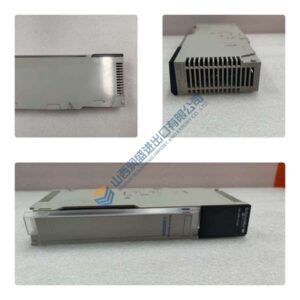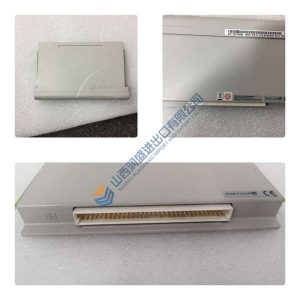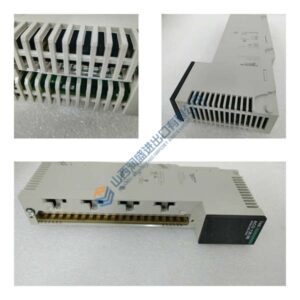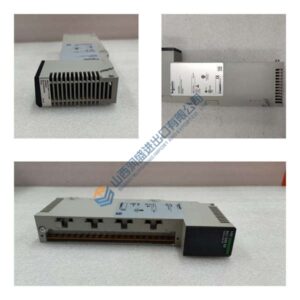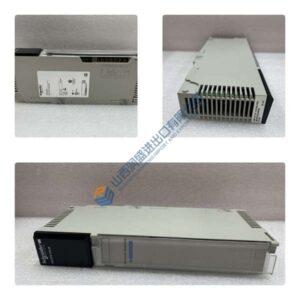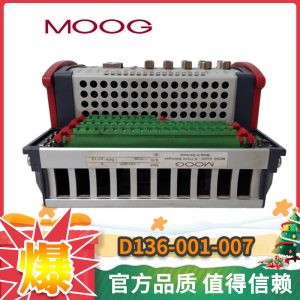Description
Detailed parameter table
| Parameter name | Parameter value |
|---|---|
| Product model | QDIO 16/16-0,5 |
| Manufacturer | Moog |
| Product category | Digital I/O Extension Module |
| Digital Inputs | 16 (24 VDC) |
| Digital Outputs | 16 (24 VDC, 0.5 A max per channel) |
| Power Supply | 24 VDC ±10%, <2 A |
| Communication Interface | Internal E-bus (for MSC I/II controllers) |
| Operating Temperature | 0…+50 °C |
| Dimensions (W x H x D) | 22.5 x 99 x 114 mm (DIN rail) |
| Weight | 0.15 kg |
| Isolation | 500 VDC (channel to channel) |
| Response Time | <2 ms (input filter), <1 ms (output) |
| EMC Compliance | EN 61000-6-2/4 (industrial) |
Product introduction
In the realm of high-precision motion control, the Moog QDIO 16/16-0,5 stands as a reliable digital I/O extension from Moog’s M3000 control system lineup, crafted to augment the capabilities of MSC I and MSC II motion controllers. This module seamlessly expands system interfacing with 16 inputs and 16 outputs, all rated at 24 VDC, to handle sensor feedback and actuator commands in synchronized automation environments. Positioned as a legacy yet enduring component in Moog’s industrial controller ecosystem, the Moog QDIO 16/16-0,5 is tailored for applications demanding robust, distributed signaling without compromising on compactness or integration ease. Its core function within automation architectures involves bridging field devices to the host controller via the proprietary E-bus, enabling real-time status acquisition and output control that underpins deterministic machine behaviors in dynamic production settings.
The Moog QDIO 16/16-0,5 delivers essential features like configurable input debouncing and output short-circuit protection, ensuring noise-resilient operation in electrically noisy factories. Mounted on standard DIN top-hat rails, it occupies minimal panel space while supporting up to 32 modules per controller chain, fostering scalable I/O architectures. Integrated with Moog’s Crisp software suite, the module facilitates straightforward parameter mapping and diagnostics, reducing commissioning times and enhancing overall system modularity. This positions the Moog QDIO 16/16-0,5 as a value-adding element by optimizing signal distribution, thereby minimizing wiring runs and bolstering fault tolerance in multi-axis servo systems.
Moreover, the Moog QDIO 16/16-0,5 reflects Moog’s legacy of precision engineering, with its rugged construction suited for continuous-duty cycles. Though designated as legacy for new designs, its proven track record in legacy upgrades and maintenance programs underscores its role in sustaining high-uptime operations, empowering engineers to maintain legacy investments while planning transitions to modern equivalents.
Core advantages and technical highlights
Signal integrity innovation underpins the Moog QDIO 16/16-0,5, where each input incorporates adjustable RC filters (1-100 ms) to suppress electromagnetic interference from nearby drives, delivering stable edge detection even in 50 Hz/60 Hz industrial grids. This allows for reliable polling of proximity switches or limit sensors at rates up to 500 Hz, while outputs employ MOSFET drivers with flyback diodes for inductive loads up to 0.5 A, preventing voltage spikes that could cascade to adjacent channels—critical for coordinated gripper sequencing without external suppressors.
Executional speed elevates the Moog QDIO 16/16-0,5, with E-bus latency under 100 µs for module-to-controller exchanges, enabling sub-2 ms end-to-end response for safety interlocks or emergency stops. Outputs support pulse-width modulation up to 1 kHz for proportional control of pneumatic valves, sustaining 100% duty cycles at 40 °C without derating, while the aggregate 8 A bus limit distributes loads evenly across chains. Low quiescent power (<1 W idle) aligns with energy-efficient panels, and status LEDs provide at-a-glance verification of channel states, streamlining troubleshooting during high-volume runs.
Fortitude is inherent to the Moog QDIO 16/16-0,5‘s build, featuring 500 VDC optical isolation per channel to isolate field faults, tested to IEC 61000-4-3 for 10 V/m radiated fields and 61000-4-6 for conducted susceptibility. Enclosed in a vibration-resistant polycarbonate housing (5-150 Hz at 2 g), it operates across 0-50 °C with 95% humidity tolerance, achieving an MTBF over 250,000 hours—suited for press shops where shock events up to 10 g occur routinely.
Adaptability integrates the Moog QDIO 16/16-0,5 into diverse frameworks, with plug-in terminals accepting 0.14-2.5 mm² wires for quick field swaps, and compatibility with MSC III via adapters for phased migrations. It maps directly into Crisp function blocks for logic embedding, supporting up to 512 I/O points system-wide.
Operational simplicity graces the Moog QDIO 16/16-0,5, with tool-free DIN latching and color-coded connectors for polarity-proof wiring, complemented by self-diagnostic loops that flag open circuits via the E-bus. Commissioning wizards in Crisp automate threshold tuning, empowering technicians to deploy full racks in hours, while error codes decode to plain text for cross-shift handovers, making elite I/O expansion approachable in motion-centric automation.
Typical application scenarios
Hydraulic test stands in aerospace manufacturing utilize the Moog QDIO 16/16-0,5 to monitor pressure transducers and toggle solenoid banks, where E-bus synchronization ensures <1 ms valve shifts during 500 bar cycle tests amid oily, 45 °C enclosures. Its debounce filters eliminate false triggers from hydraulic pulsations, addressing test engineers’ precision mandates by logging input states for FAA-compliant traceability—resulting in 20% faster validation runs, as output diagnostics preempt leaks that could idle multi-ton fixtures in prototype wing assembly.
Plastic injection molding cells deploy the Moog QDIO 16/16-0,5 for core pull verification and ejector actuation, coordinating 16 molds per machine under 80% RH molding halls with steam bursts. Outputs at 0.5 A drive heater relays without relays, fulfilling cycle masters’ 30-second takt needs through isolated channels that confine shorts to zones—enhancing defect rates below 0.5% via real-time feedback that adjusts clamp forces, optimizing material flow in high-cavitation tools for automotive trim production.
Wind tunnel simulators harness the Moog QDIO 16/16-0,5 for flap position sensing and damper control, interfacing 16 vanes in subsonic flows up to 100 m/s with turbulent air eddies. The module’s EMC shielding sustains signal fidelity amid generator noise, meeting aerodynamicists’ data integrity goals with timestamped captures—cutting wind-on time by 15% through proactive fault isolation that sustains airflow uniformity, vital for validating turbine blade profiles in renewable energy R&D.
Related model recommendations
- QDIO 8/8-0,5: Compact eight-channel variant in the QDIO series, ideal as a localized supplement to the Moog QDIO 16/16-0,5 for end-effector I/O in space-limited servo end nodes.
- QAIO 16/4: Analog I/O module with 16 inputs and 4 outputs, serving as a signal-mixed counterpart to the Moog QDIO 16/16-0,5 for hybrid sensor fusion in test benches.
- QDIO 16/16-1,0: Higher-current 1 A output edition, functioning as a power-upgraded alternative to the Moog QDIO 16/16-0,5 for inductive loads like larger solenoids in presses.
- MSC I Controller: Base motion controller that the Moog QDIO 16/16-0,5 extends via E-bus, essential for multi-axis coordination in legacy M3000 systems.
- QDIO 32/32-0,5: High-density 64-channel model for central expansions, acting as a scalable successor to the Moog QDIO 16/16-0,5 in rack-based architectures.
- G121 I/O Module: Modern EtherCAT variant from Moog’s G-series, recommended as a next-gen replacement for the Moog QDIO 16/16-0,5 in fieldbus migrations.
- QDIO 16/16-S: Safety-rated SIL 2 version, complementing the Moog QDIO 16/16-0,5 with dual inputs for certified emergency circuits per EN ISO 13849.
Installation, commissioning and maintenance instructions
Installation preparation
Environment scouting for the Moog QDIO 16/16-0,5 follows EN 60204-1: uphold 0-50 °C with <95% RH noncondensing, buffered from conductive swarf by IP20 enclosures to guard E-bus integrity. Stock a lineup with 0.6 Nm hex drivers for cage clamps, shielded 24 AWG for field ties, and E-bus ribbon cables (50-pin IDC); ratify 24 VDC at <5% ripple from SELV origins at 2 A peaks. Prime directives enforce LOTO on supplies, continuity probes on inputs, and load resistors on outputs—insisting on chassis grounds <0.1 Ω to repel transients, as module addressing via DIPs prearms for chain harmony, refining rack-ins to 20 minutes.
Maintenance suggestions
Curated routines for the Moog QDIO 16/16-0,5 embrace bimonthly LED sweeps for dropout cues and Crisp scans to calibrate filter spans, foreclosing noise ingress from VFD harmonics in servo bays. Inquests via E-bus queries unveil latch-ups—alleviated by terminal purges or gain resets—while audit trails chronicle states for variance hunts. Rejuvenations summon power shed, snap disengages, and pin buffs with probes; hoard authentic ferrules and diodes to peg turnarounds at 30 minutes. Annual firmware infusions by E-bus and EMI audits in dynamic zones conserve acuity, molding a watch that hurtles the Moog QDIO 16/16-0,5 beyond 10 years with visionary, docketed prescience.
REXROTH INDRAMAT MAC112D-1-ED-2-C/130-A-0 Servomotor
REXROTH INDRAMAT MHD112C-024-NG0-AN Servomotor
Indramat Servo Motor MKD MKD090B-058-KP1-KN
Indramat Rexroth PPC-R02.2N-N-Q1-T2-NN-FW
Indramat bedieneinheit BTV20 BTV20.2CA-64B-10C-D-FW
INDRAMAT AC-SERVOANTRIEBSMODUL TDA 1.3-100-3-A00
Indramat DLC2 109-0919-4B29-02
Indramat 112D-0-FD-2-C/1?30-A-2/S013 Servomotor
indramat Modul DKC02.3LK SCK02/01 Serco neu






